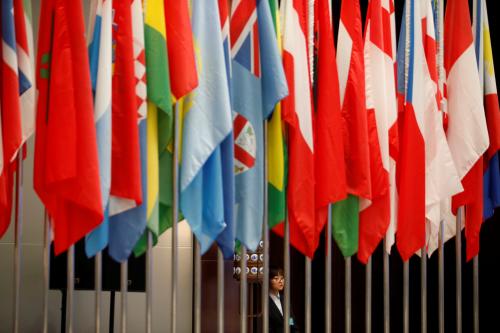 It’s easy to feel a sense of déjà vu in the world of U.N. climate negotiations. After all, it’s the 24th Conference of the Parties this year, and many of the same old issues just don’t seem to get resolved, so they come around again, and again.
It’s easy to feel a sense of déjà vu in the world of U.N. climate negotiations. After all, it’s the 24th Conference of the Parties this year, and many of the same old issues just don’t seem to get resolved, so they come around again, and again.
With climate finance, as the late street philosopher Yogi Berra said, “It’s déjà vu all over again.”
A few days ago, the OECD released a report on “climate finance from developed to developing countries” stating that public climate finance reached $56.7 billion in 2017. It is not the first time that the OECD published figures claimed as relevant for the $100 billion a year promise that was first made in Copenhagen in 2009 and reiterated several times since then. The last OECD report was released in 2015, a couple of weeks before the big COP21 in Paris. But remember, it didn’t go that well at the time.
Developing nations’ representatives bristled in 2015 at the OECD report’s conclusions. A response by the Indian Ministry of Finance noted that the only credible number was “$2.2 billion (…) and not $57 billion average for 2013-14 as exaggeratedly reported by the OECD.”
The new OECD report confirms our belief that there is still no number that could be arrived at that would be credible to all parties in the climate negotiations. This is because the question of what counts as “climate finance” is still not internationally agreed-upon under the UNFCCC.
In the absence of any common accounting methodology under the UNFCCC, contributor countries have been able to decide in a vacuum what they would count as part of their commitment to mobilize $100 billion by 2020. The consequence of this is that contributing countries have adopted a variety of accounting and reporting practices, which impedes the generation of comparable data on climate finance, as detailed in a very recent UNFCCC report.
The legitimacy of rich countries to define for the world what should count as “climate finance” has been widely questioned by observers, including ourselves. Is it acceptable to see more than 150 Parties to the UNFCCC being excluded from definitional discussions around climate finance?
The OECD seems to be much more careful in its approach this time, stating that “the report is without prejudice to the ongoing negotiations under the UNFCCC towards the development of . . . modalities for the accounting of financial resources provided and mobilized through public interventions.”
But despite the latest OECD caveats, we do not think much has changed in the climate finance accounting muddle since 2015.
Worrying trends in the figures
Despite numerous COP decisions urging developed country parties to provide climate finance in a balanced manner between adaptation and mitigation, and then to significantly increase adaptation finance, the problem persists. According to the OECD, “The thematic split of bilateral climate finance remained broadly stable: mitigation continues to represent two-thirds ($17.8 billion in 2017, up from $15 billion in 2013), and adaptation slightly more than 20 percent ($5.6 billion in 2017, up from $4.7 billion in 2013).”
It is also very worrying that what is presented as an increase in climate finance is mainly due to an increase in the provision of loans rather than grants. Grant financing rose by 25 percent (to $12.8 billion) and loans doubled to $40.3 billion. Loans still represent most of bilateral and multilateral climate finance, despite numerous demands from developing countries for climate finance mainly in the form of grants, especially for adaptation. But it’s déjà vu all over again: “Grants represent over a third of bilateral and less than 10 percent of multilateral climate finance. Loans accounted for about 60 percent of bilateral and close to 90 percent of multilateral climate finance.”
In addition, the OECD still presents export credits provided by developed countries’ official export credit agencies as climate finance—not what developing countries had in mind when they heard the $100 billion pledge. The OECD is well aware that its choice to include export credits is controversial, stating: “Export credits provided by developed countries’ official export credit agencies are presented as a separate category from public climate finance. This is because they do not qualify as official development finance due to their financial terms and conditions as well as trade-related aim.”
Another disturbing element is that the OECD is unable or unwilling to present data on mobilized private finance for 2015-2017. This is despite numerous statements from rich country officials claiming that most climate finance will come from the private sector.
What’s missing in the new figures
The report eludes key elements in international climate finance discussions. For example, the issue of “additionality” (whether funds are “new and additional”) is not even mentioned in the OECD report. Is climate finance being siphoned off from development assistance? The OECD report does not provide any clarity on that issue.
The report does not give any figures on individual developed countries’ contributions to international climate finance efforts. It is therefore impossible to know which developed country provides its fair share of climate finance, and to identify countries that are climate finance champions or laggards. Why would champions agree to be lumped in with laggards? We are left to believe that the absence of any information about each developed country’s contribution to climate finance is an admission of the fact that the climate finance’s figures reported by developed countries are not comparable with each other. That is because pretty much every developed country has its own climate finance accounting methodology.
Similarly, the report lacks any information about the allocation of climate finance to individual recipient countries. This makes it impossible to know if some developing countries are “climate finance orphans.” Opportunities for the report to inform allocation decisions are foregone.
In 2015, the OECD stated, “The group intends to provide information on public budgetary sources and/or grant equivalent in future reporting.” It is therefore extremely disappointing to see that three years after this statement the OECD is still unable or unwilling to provide information on a grant-equivalent basis. All financial instruments are accounted for at cash face value in the figures of the OECD 2018 report. This means that a $50 million grant appears to be equal to a loan of $50 million in the figures put forward by the OECD.
Some experts, including Amar Bhattacharya, who was among the ten contributors who aired their views on COP24 in a November 29 Around the Halls Brookings blog post, are determined to focus on (and advocate for) partnerships that will exponentially scale up financing. While we commend their push for a transformation of the global financing system and admire their ambition, we believe that the “shifting to trillions” narrative should not obscure the unresolved $100 billion question.
Is there a real number in climate finance?
Fierce contestations on what levels of funding are actually flowing to developing countries for climate objectives will continue until a robust accounting methodology is defined under the UNFCCC. Our more pessimistic view is that this needs to be completed before finance flows will build trust between developed and developing countries.
COP21 called for the development under the UNFCCC of “modalities” to account for climate finance. Such modalities are supposed to be considered at COP24. More than considered, these modalities need to be decided, so the world can get on with this. The next few days in Katowice will be crucial in redressing the current dysfunction. Only then will the cycle of climate finance “déjà vu all over again” end.
The Brookings Institution is committed to quality, independence, and impact.
We are supported by a diverse array of funders. In line with our values and policies, each Brookings publication represents the sole views of its author(s).








Commentary
It’s déjà vu all over again: Climate finance at COP24
December 6, 2018